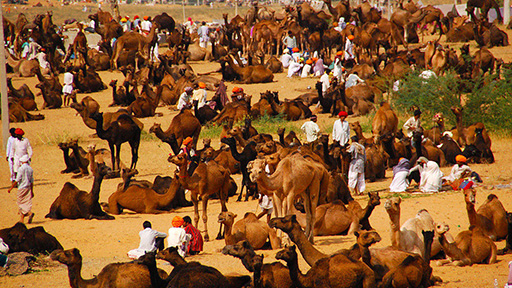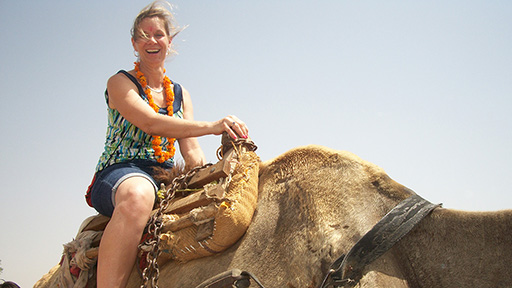
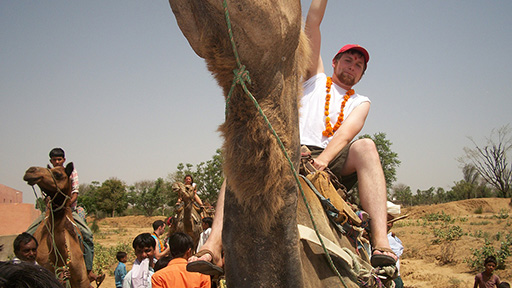
Take a camel ride
Key points
- Taking a camel ride is a fun way to tour Ikaki Bagh and the local countryside
- Camels are an incredible story of adaptation making them excellent for desert conditions
- Camels are important in Rajasthan today for dairying, tourism and helping preserve desert cultures and traditions
Rajasthan is famous for its camels and traditional camel culture.
Camels are fascinating animals, intelligent, cheeky and often playful. They can also be wilful and cranky but respond well to consistent training, patience and good care.
Camel experiences we offer
At Ikaki Bagh, we can offer a variety of camel experiences as part of any visit.
Popular with small groups is a short tour of our farm in a camel cart. This includes a talk about the characteristics of a camel and the history and tradition of the animals. You can also take individual short rides on a camel led by an experienced handler.
We design longer riding tours through the local countryside travelling by camel or camel cart.
All camel experiences must be pre-arranged as part of your overall visit tour plan.
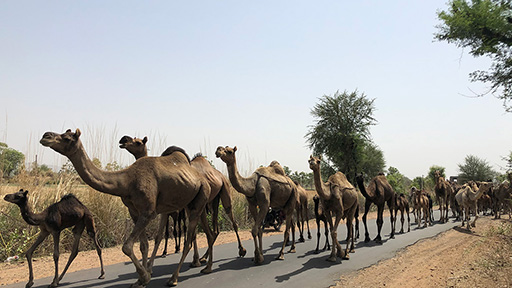
A unique animal
India is at the Eastern end of the range of the one humped camel (Camelus Dromedarius). This breed of camel extends from Northern Africa across the Middle East to India.
The camel is uniquely adapted to the desert. 80% of India’s camel population is found in Rajasthan. The rest of the population is in the adjoining States of Gujarat and Haryana.
Camels mostly graze on various drought resistant trees and shrubs of the desert. Their thick lips enable them to eat thorny plants comfortably. They particularly like thistles.
Camels learn which trees and shrubs to feed on from their mothers. Almost all plants that camels eat are known for their medicinal values and are used in folk medicines. Traditional herdsmen insist camel milk derived from plants indigenous to the region is far superior in quality.
It is often said a camel is a horse designed by a committee. This reflects the extraordinary number of adaptations that enable the camel to work and survive in desert conditions. Adaptations include:
- Camels drink about 40-50 litres of water per day in Summer helping their bodies rehydrate faster than any other mammal.
- Their hump is a big storage tank of fat, not water. When they cannot find food, they use this fat for energy surviving up to six months.
- They are exceptionally strong. They can carry 900 pounds (400 kilos, close to their own body weight ) in a day for at least 25 miles (40 kms).
- The large feet are ‘fat pads’ (without hooves) helping them to walk hot sand and without sinking.
- A camel’s body temperature changes during the day and they do not sweat. This helps them conserve water.
- Camels have three sets of eyelids and two sets of eyelashes. Their ears are covered in hair inside and out. These adaptations protect them against dessert sands, especially wild storms.
- It is the male camel, not the female, that comes in season indicating it is ready to mate. During the heat period the male releases a black pigment from a gland at the back of the head. This attracts females to the act of mating called as “lakhana” in Rajasthan.
- A camel stallion can cover up to 40 females each season.
Hearing camels communicate is a memorable experience. As herd animals, they have a wide range of growls interspersed with snorts, moans, groans and high-pitched bleats.
A note of trivia, is the rumbling growl was one of the noises used to create the voice of ‘Chewbacca’, the well-known character in the Star Wars movies.
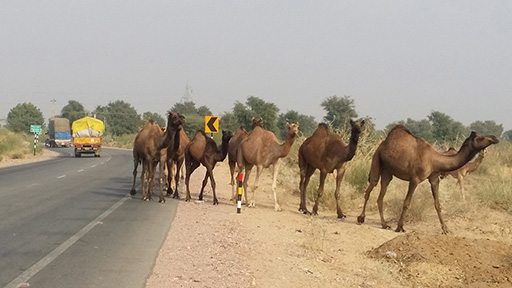
History and tradition in Rajasthan
In 2014, the Government of Rajasthan declared the camel the Official State animal.
This reflected the proud historical tradition of the camel as well as increasing concern at dwindling numbers of the camel population in the State.
Camels are ideally suited to live and work in the vast Thar Desert. This desert is approximately 200,000 sq. kms and provides a natural boundary between India and Pakistan.
Camels first appeared in Rajasthan around the 7th century A.D. 3000 camels were part of the military force in the Muslim invasion of Sindh (in modern day Pakistan) in the 7th century.
By the late 9th century, camels were being used in the today’s North-West Rajasthan to carry water. We also have evidence of camels playing a role in desert trade in Western Rajasthan by the 12th century.
Camel Corps to be used for warfare were well-established by time of the Mughal Emperor Akba. Maharajahs of Rajhastan formed their own camel corps establishing a very proud military tradition. This tradition continued well in to the twentieth century with the famous Ganga Risla (Bikaner Camel Corps) serving with distinction in the Middle East and Egypt in WWI and WWII.
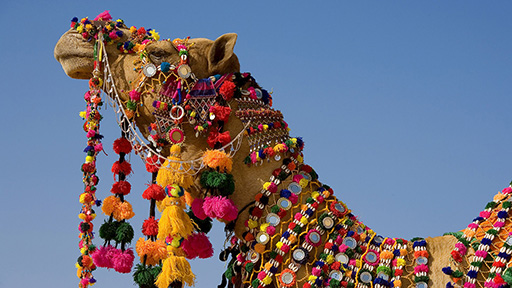
Pushkar Camel Fair
The cultural, historic and economic significance of the camel in Rajasthan is celebrated at the annual Pushkar Camel Fair.
The Fair was established to attract local camel and cattle traders to do business during the holy Kartik Purnima festival. The festival falls in late November each year.
Pushka is a small town on the edge of the Thar Desert set on the edge of Psuhkar Lake. It is an exceptionally important religious site with hundreds of temples. Particularly distinctive are the 52 ghats, or stone staircases, that lead to the lake where pilgrims bathe.
The Camel Fair has become a major tourist attraction. A large variety of activities are staged for tourists in addition to enjoying and appreciating the camel and cattle trading.
Human relationship
Especially fascinating is the story of deep human to camel relationship that formed over the centuries.
Camel herding was a traditional speciality of the Raikas, a migratory people of Rajasthan. This caste some of the deepest traditions in camel culture with their distinctive customs and migratory lifestyle.
Raikas consider their animals as akin to their own children. They were never used for meat or sold for slaughter.
Raikas also regularly shear their camels providing a source of camel hair. The hair is woven into rugs using traditional tribal patterns.
Traditionally, camel milk was always consumed fresh and never processed. The milk was never sold. Instead, it was believed the milk should be given away free if it could not be consumed fresh.
A famous Raika proverb is, “Dudh bechna, beta bechna” meaning, “To sell milk is like selling one’s own son.”
Traditional beliefs have given way to more pragmatic times. Camel dairying has become an important economic lifeline for camel pastoralist communities.
The camel also continued its role as an important draught animal. A two-wheeled cart using aeroplane types has been popular although increasingly supplanted by affordable trucks and tractors. Nonetheless, these are still quite a common site in rural Rajasthan.
The Future
By the 1990s, camel numbers began dropping quite substantially for a complex set of reasons including loss of grazing areas, disease and closure of traditional markets.
More recently, a lot of effort has gone into restoring and protecting camel populations. This includes improved animal husbandry, increased use for dairying and more widespread participation in tourism.
We are confident you will have a memorable time with your own ‘camel experience’.
